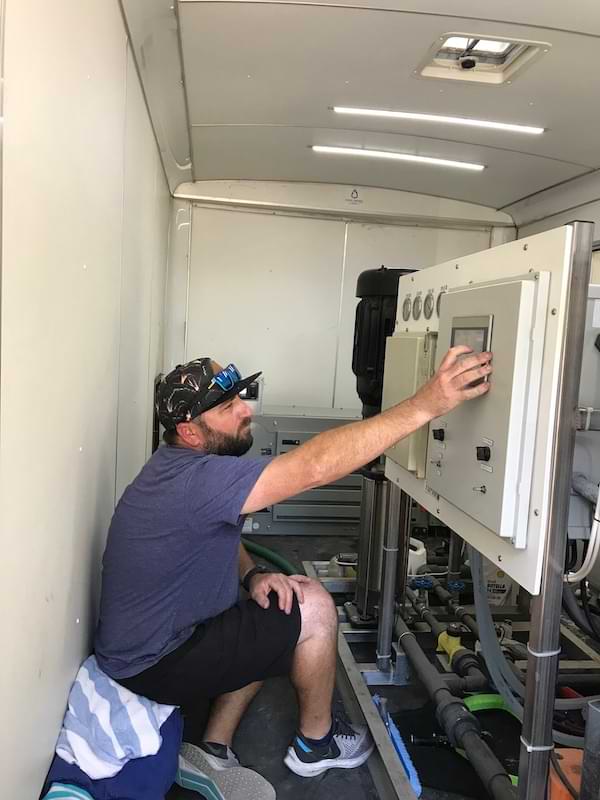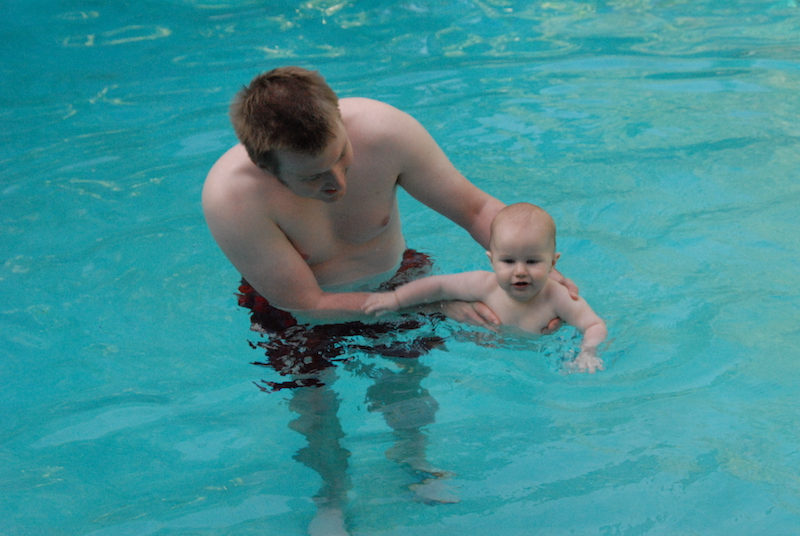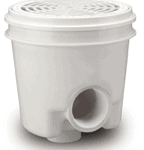Swimming pool water recycling removes unwanted minerals, salts, and impurities from the water, eliminating the waste involved in draining and refilling.
Has your swimming pool service recommended that you drain and refill your pool because the water has gone bad? If so, you’re probably conflicted about wasting a ton of water, especially if you live in an area suffering from drought. Fortunately, there is an alternative to draining a pool: pool water recycling. In this article, we’ll look at the reasons for draining or recycling pool water, the techniques and costs involved in recycling, and whether recycling might be the right option for pool owners.
Swimming pool water recycling is done by a special pool service that is equipped with the extensive (and expensive) equipment necessary to handle the recycling process. They have a trailer with giant reverse osmosis filters (RO filters) and other gear for testing your water, pumping it out of your pool, processing it, and returning it to your pool. It’s like dialysis for your pool. The system is self-sufficient—it even has its own generator for providing the power to run the pumps and equipment.
The company typically leaves the trailer parked and operating at your property for 12 hours or more, depending upon the size of your pool. Because the water flows through the pumps and filters and returns to your pool, your swimming pool is never empty. You and your guests can swim in the pool while the recycling system is running.
Just like a kitchen sink RO filter, this process basically takes everything out of the water, leaving a pool that is filled with water that’s pure and practically mineral-free.
Why Does Swimming Pool Water Need to Be Drained or Recycled?
Swimming pool water is drained so that hard mineral-laden water can be replaced with softer, clearer, fresh water—usually from an outdoor faucet.
Evaporation causes swimming pool water to become saturated with salts and minerals because, when the pool water evaporates, it leaves behind the minerals. Thanks to the large surface area of swimming pools, they can lose about 600 gallons of water per week through evaporation (unless they have pool covers, which is a great reason to keep your pool covered).
The “hardness” minerals and salts left behind are known—and measured—as “total dissolved solids” or “TDS.” Hardness minerals build up month-after-month and year-after-year. Over time, the buildup of minerals and salts becomes corrosive to pool equipment, pool plumbing, and swimming pool surfaces. It also causes skin and eye irritation. In addition, this hard water does a very poor job of retaining chlorine and other chemicals that keep the water clear and safe. Eventually, your pool service typically wants you to empty the pool and refill it with fresh water.
Pool service providers generally say that swimming pool water should be emptied and replaced every 5 to 7 years, but the actual need is determined by water quality measurements of hardness (TDS), pH, alkalinity, chlorine, cyanuric acid (CYA), and more.
Pool Draining vs Recycling
Most swimming pools hold 15,000 to 20,000 gallons of water. Draining and refilling that much water can be a huge waste, considering how precious this resource is—particularly in arid, drought-stricken regions, which are many. According to the EPA, at least 40 states are anticipating water shortages by 2024.
Of course, DIY homeowners can drain existing water and refill their own pools relatively inexpensively, especially where water costs are low. But note: Before emptying your swimming pool, consult with a swimming-pool repair professional. Emptying a swimming pool can also be dangerous for the pool.
A conventional concrete pool is surfaced with plaster that can dry and crack if it isn’t protected by water. In addition, the water’s heavy weight essentially holds a pool in the ground. Without the weight of water, the groundwater around a swimming pool could apply enough hydrostatic pressure to float an empty pool out of the ground, especially in winter when the ground is saturated (though many in-ground pools are built to prevent this from happening). Similarly, vinyl-lined or fiberglass pools can be damaged (and warranties can be voided) if they’re emptied without care for proper procedures.
Pool water recycling is a form of water conservation that saves about 85% of your pool’s water—a small percentage of RO reject water (also called “waste stream” or “brine”) that’s filled with the contaminants is drained into the sewer. It removes TDS, calcium, excess conditioner (cyanuric acid, or “CYA”), nitrates, phosphates, and waterborne diseases. Most swimmers report that RO filtering makes the water feel great for swimming, too.
Here is a comparison of the cost to empty vs. the cost to recycle your pool water. Keep in mind that these comparisons are just about cost. It’s clearly more environmentally responsible to save the water by recycling it.
Cost to Drain and Refill a Pool
The cost to empty and refill a pool depends on several factors, including the cost of water, your pool’s size, pool service cost, and replacement pool chemicals cost.
Cost of water. Definitely expect a higher water bill. How much higher will depend on your local water rates, which can vary dramatically across the US. Rates can run from $2.50–$9.00+ per thousand gallons of water. If you’re weighing the cost of doing this, call your water company and find out your water rates.
Size of pool. Of course, the size of your pool will determine the amount of water you’ll need. Most in-ground pools are 18,000 to 20,000 gallons of water. A 12-by-24-foot pool might be closer to 10,000-gallons of water. A 20,000-gallon pool is roughly 16×34 feet—water cost will usually run $50–180.
Pool service costs. Ask your pool service what they would charge to drain and refill your pool. To bring hoses, set up the pumps, and handle this process, expect a charge of $150–200, not including water and chemicals.
Pool chemical costs. Your pro will also need to add enough pool chemicals for basic pool maintenance and to bring the new pool water’s chlorine, alkalinity, and calcium levels into balance. In total, these can cost $50–300, depending on how much water your pool holds and the chemicals needed.
In total, figure that draining and refilling your pool can easily run $500–700.
Cost to Recycle Pool Water
This is a relatively new service that is growing quickly. As a result, you’ll probably need to use a free service like Yelp to find a water recycling pro near you.
The factors that affect pool water recycling are the recycling service cost and the size of your swimming pool. The main expense for the service is hauling the recycling trailer to your home and tying up their equipment for a given period of time—usually at least 12 hours. With this in mind, the further they must travel and the longer they must leave the trailer at your home, the more it will cost.
Because services are few and far between, getting competitive bids may be a challenge. Typical prices are $600–900 for a 20,000-gallon pool. Larger pools cost incrementally more, just because they take longer. Travel time, set-up, and take-down of equipment is the same, regardless of your pool’s size. While recycling costs are typically more than water replacement in some areas, the thousands of gallons of water saved and ease of application make it a great choice.
Case Study: Recycling Pool Water
We tried pool water recycling on an 18,000-gallon pool that was significantly out of balance—it had extreme hardness, and the pool service had recommended draining and refilling it. After considering the issues of wasting water in a severe drought, we called Pool Water Recycling (PoolWaterRecycling.net) in Orange County, California, and worked with their water purification specialists, Nick Leatherwood and Lisamarie Silva.
Below is a TikTok video that we made about this:
They parked their recycling trailer at the driveway and started by testing the existing pool water. The measurements were as follows, measured in parts per million (ppm):
Free chlorine: 5.0 ppm (Ideal is 3.0–5.0)
Water pH: 7.6 (Ideal is 7.4–7.6)
Total alkalinity (TA): 140 ((Ideal is 80–120)
Calcium hardness: 1,000 (Ideal is 200–400)
Total dissolved solids (TDS): 3,605 (Ideal is under 2000)
Conditioner / cyanuric acid (CYA): 300 (Ideal is 30–80)
Salinity: 2456
Next, they neutralized the pool to get all of the chlorine out by casting a powder (sodium metabisulfite) into the pool. They turned on the pump to circulate the water a bit, and then shut down the pump before running their equipment.
They ran large hoses from the swimming pool to the trailer. When everything was set-up, they started the trailer’s diesel generator and turned on the pumps.
Nick monitored everything on the system’s control panel, but pointed out that he could even do this from home.
“With the technology now, I have a monitor that I monitor remotely. I can adjust it. This trailer runs for an average of 12 or 15 hours. I’ll be at home cooking or barbecuing with my laptop nearby and I can watch the system as I’m cooking dinner,” he says. “It shuts itself down, and sends me a text message, “Hey I’m done, come pick me up.”
And that’s exactly what he did the following morning. He disconnected and rolled-up the hoses and re-tested the water. The new numbers were strikingly pure:
Free chlorine: 1 ppm
Water pH: 7.2
Total alkalinity (TA): 60
Calcium hardness: 190
Total dissolved solids (TDS): 422
Conditioner / cyanuric acid (CYA): 30
Salinity: 296
He added some chlorine and bicarbonate to raise chlorine and alkalinity levels and some conditioner to slightly raise the CYA, and he was done.
The pool was sparkling clean and, of course, we had to jump in to test the feel of the water. It was awesome!















 Don Vandervort writes or edits every article at HomeTips. Don has:
Don Vandervort writes or edits every article at HomeTips. Don has:




